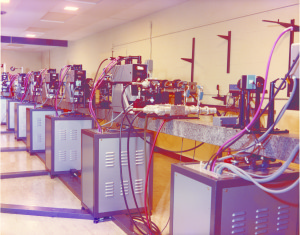Star Wars – Advancement of Laser Peening
The defense program “Star Wars” led to many technological investigations and discoveries; laser peening was one of those fledgling technologies that benefited.
Posted: December 21, 2015
By: wpengine
Star Wars helped develop laser peening. Ronald Reagan’s Strategic Defense Initiative was nicknamed “Star Wars” after the 1977 episode release. The defense program “Star Wars” led to many technological investigations and discoveries; laser peening was one of those fledgling technologies that benefited. Battelle Columbus Labs had already patented “Laser Shock Peening” in the early 1970’s and had made some inroads to advance the field. But laser advancements made through the “Star Wars” initiative, which incorporated a focus on the use of high power lasers to protect America from incoming missiles, provided technology that could be used to design a high power laser for laser peening.
Battelle had a large high energy laser left over from a 1970s laser fusion program, with numerous laser amplifier stages (in total it was more than 50 feet long, the final stages with laser glass rods 120 mm diameter and almost a meter long). Many of LSP Technologies’ Senior Engineers were scientists for Battelle at the time, and they were using this system in single pulses of 100-1000 Joules at 20 ns, and up until this time the system was only capable of firing every 6 to 8 minutes. With the “Star Wars” effort, they modified the flashlamp pumping from short individual 400 µs pump pulses to much longer long flashlamp pump pulses in excess of 100 ms. By staggering the amplifier firing times, they extended the pumping period for the entire system to about a second. They then used a modified high repetition rate oscillator to inject a “pulse train” into the amplifier chain, creating a burst of laser pulses. This gave them the ability to create pulse trains of up to about 1000 Hertz for the short burst period. The system could be used to rapidly test laser/metal interactions for material improvements such as fatigue and damage tolerance increases (actually well in excess of modern industrial laser peening repetition rates).
All of the design modifications required to transform a huge, antiquated, single pulse, high energy laser into a 200 kW burst laser were provided by the SDI “Star Wars” initiative. This opened the path for Battelle to significantly shrink the size of the laser components and develop the first-ever high power laser system designed specifically for laser peening. That first laser shock peening system was a 50 J system that operated at 1 Hz on a table just bigger than a normal desk. Star Wars, the movie, as with many sci-fi movies, whetted the appetite of scientists and engineers everywhere, with Light Sabers, and all the other imaginative creations, which led directly to developments in real world technologies, helping laser peening jump from laboratory experiment to industrial process.
Interested in Seeing More?
Tell us about your application, material, or failure mechanism and we will have one of our experts reach out to you. Our extensive library of research and years of experience gives us a unique advantage to apply a finite element analysis to help diagnose the best application for your situation.

